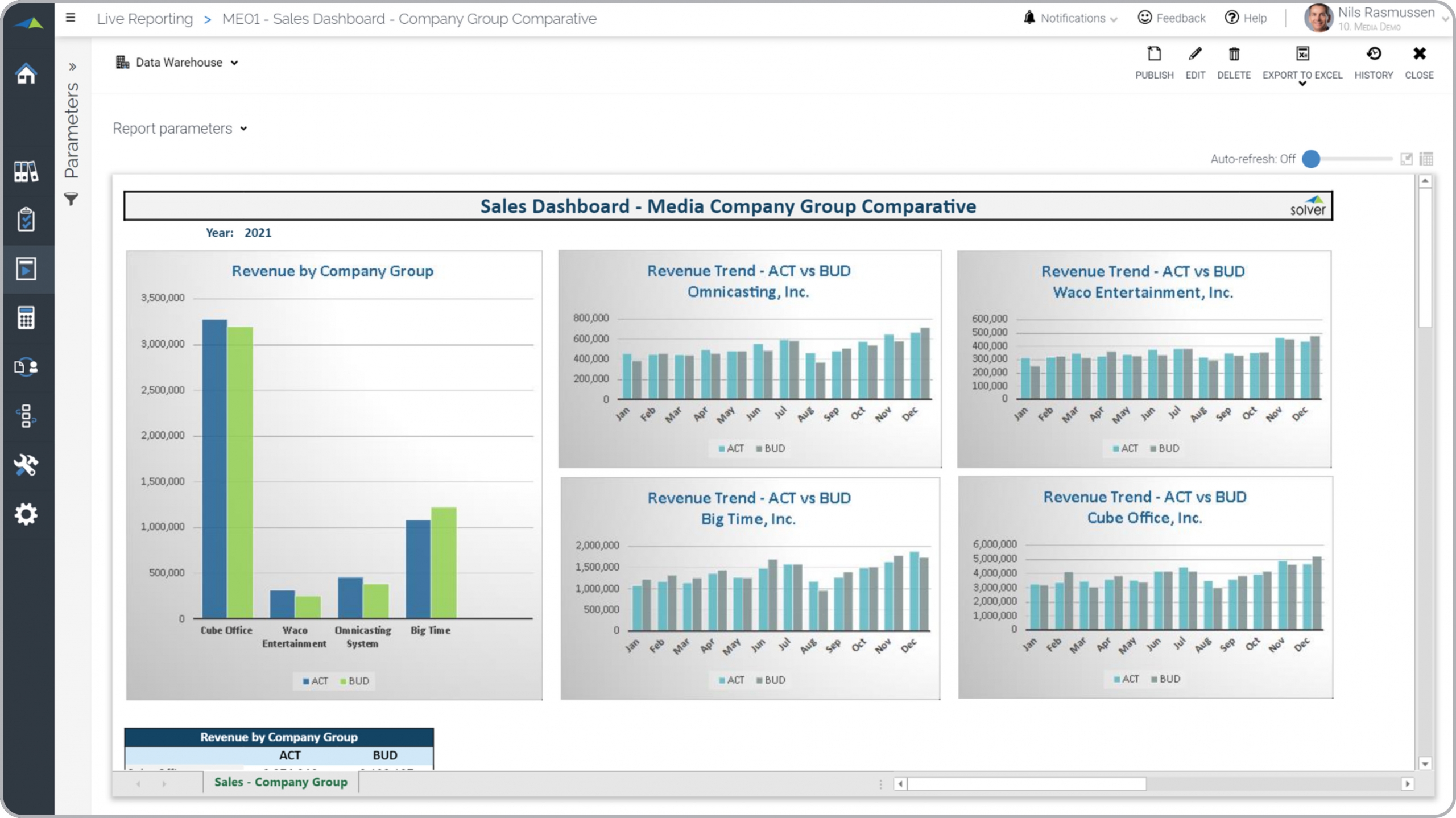Revenue Comparison Dashboard for Media Companies
What is
a
Revenue Comparison Dashboard
? Revenue Comparison Dashboards are considered benchmarking tools and are used by executives to compare revenues and sales across their media companies. Some of the main functionality in this type of report is that it provides sales comparisons from two different perspectives: 1) Actual and budget benchmark across the company's subsidiaries, 2) Revenue trend for each subsidiary with actual and budget comparison. You find an example of dashboard report below.
Purpose of
Revenue Comparison Dashboards Media companies use Revenue Comparison Dashboards to benchmark sales performance and analyze monthly trends with budget variances. When used as part of good business practices in Executive and Financial Planning & Analysis (FP&A) departments, a company can improve its revenue growth strategies, and it can reduce the chances that managers don't see important under- or over-performers with resulting delays in decision-making.
Example of a
Revenue Comparison Dashboard Here is an example of a Revenue Dashboard with subsidiary comparison, budget to actual and trend analysis. [caption id="" align="alignnone" width="2560"]
 Example of a Revenue Comparison Dashboard for Media Companies[/caption] You can find hundreds of additional examples
here
Who Uses This Type of
Dashboard report
? The typical users of this type of dashboard report are: Executives, VP of Sales, Sales Managers, Budget Managers.
Other Reports Often Used in Conjunction with
Revenue Comparison Dashboards Progressive Executive and Financial Planning & Analysis (FP&A) departments sometimes use several different Revenue Comparison Tools, along with sales dashboards, sales forecasts, consolidating profit & loss reports, annual budgets, financial dashboards, KPI dashboards and other management and control tools.
Where Does the Data for Analysis Originate From? The Actual (historical transactions) data typically comes from enterprise resource planning (ERP) systems like: Microsoft Dynamics 365 (D365) Finance, Microsoft Dynamics 365 Business Central (D365 BC), Microsoft Dynamics AX, Microsoft Dynamics NAV, Microsoft Dynamics GP, Microsoft Dynamics SL, Sage Intacct, Sage 100, Sage 300, Sage 500, Sage X3, SAP Business One, SAP ByDesign, Acumatica, Netsuite and others. In analyses where budgets or forecasts are used, the planning data most often originates from in-house Excel spreadsheet models or from professional corporate performance management (CPM/EPM) solutions.
What Tools are Typically used for Reporting, Planning and Dashboards? Examples of business software used with the data and ERPs mentioned above are:
Example of a Revenue Comparison Dashboard for Media Companies[/caption] You can find hundreds of additional examples
here
Who Uses This Type of
Dashboard report
? The typical users of this type of dashboard report are: Executives, VP of Sales, Sales Managers, Budget Managers.
Other Reports Often Used in Conjunction with
Revenue Comparison Dashboards Progressive Executive and Financial Planning & Analysis (FP&A) departments sometimes use several different Revenue Comparison Tools, along with sales dashboards, sales forecasts, consolidating profit & loss reports, annual budgets, financial dashboards, KPI dashboards and other management and control tools.
Where Does the Data for Analysis Originate From? The Actual (historical transactions) data typically comes from enterprise resource planning (ERP) systems like: Microsoft Dynamics 365 (D365) Finance, Microsoft Dynamics 365 Business Central (D365 BC), Microsoft Dynamics AX, Microsoft Dynamics NAV, Microsoft Dynamics GP, Microsoft Dynamics SL, Sage Intacct, Sage 100, Sage 300, Sage 500, Sage X3, SAP Business One, SAP ByDesign, Acumatica, Netsuite and others. In analyses where budgets or forecasts are used, the planning data most often originates from in-house Excel spreadsheet models or from professional corporate performance management (CPM/EPM) solutions.
What Tools are Typically used for Reporting, Planning and Dashboards? Examples of business software used with the data and ERPs mentioned above are:
- Native ERP report writers and query tools
- Spreadsheets (for example Microsoft Excel)
- Corporate Performance Management (CPM) tools (for example Solver)
- Dashboards (for example Microsoft Power BI and Tableau)
Corporate Performance Management (CPM) Cloud Solutions and More Examples
July 23, 2021
TAGS:
Reporting,
Solver,
print,
report writer,
Microsoft,
benchmark,
template,
practice,
Acumatica,
Netsuite,
TV,
streaming,
Finance,
planning,
GP,
Business Central,
excel,
radio,
ax,
forecast,
Budget,
Dynamics 365,
budgeting,
revenue,
Cloud,
Software,
Tableau,
SAP,
example,
media,
best,
Sage,
BC,
D365,
NAV,
Intacct,
broadcast,
online,
CPM,
report,
SL,
Management,
dynamics,
sales,
Power BI,
revenue analysis,
media dashboard,
comparative,
monthly revenue trend

